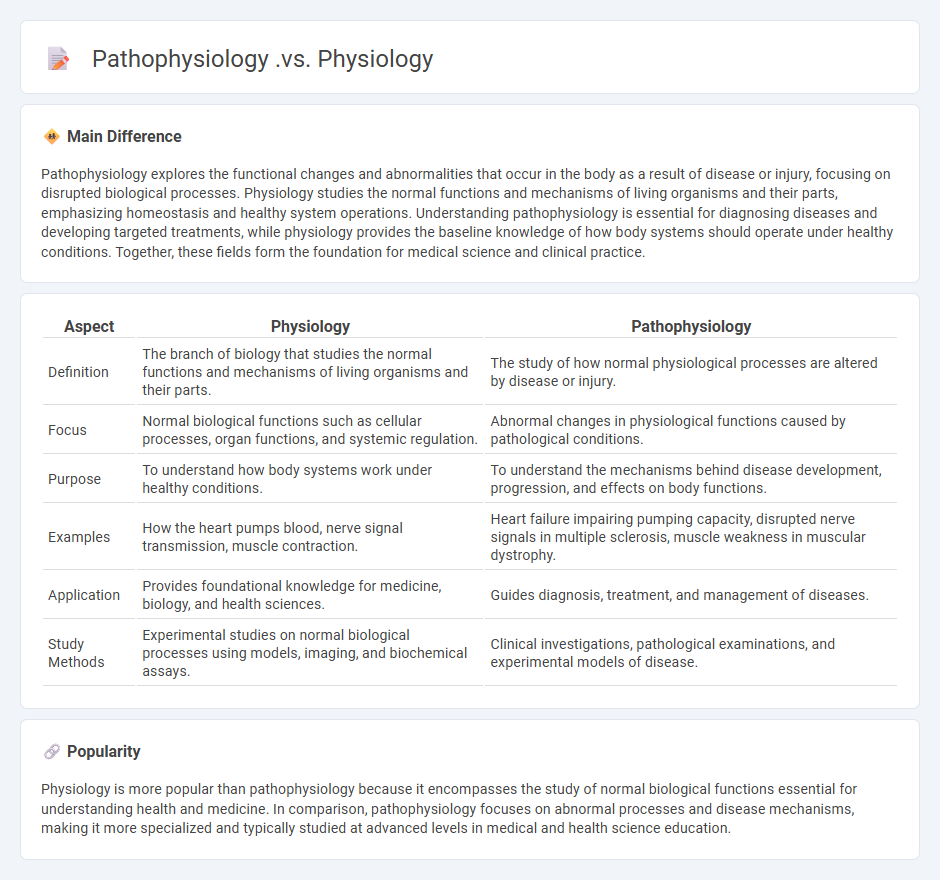
Pathophysiology examines the disordered physiological processes associated with disease or injury, contrasting with physiology which studies the normal functions of living organisms. Understanding the mechanisms behind pathological conditions provides crucial insights into diagnosis, treatment, and prevention strategies. Explore further to uncover the detailed differences and clinical applications of pathophysiology versus physiology.
Main Difference
Pathophysiology explores the functional changes and abnormalities that occur in the body as a result of disease or injury, focusing on disrupted biological processes. Physiology studies the normal functions and mechanisms of living organisms and their parts, emphasizing homeostasis and healthy system operations. Understanding pathophysiology is essential for diagnosing diseases and developing targeted treatments, while physiology provides the baseline knowledge of how body systems should operate under healthy conditions. Together, these fields form the foundation for medical science and clinical practice.
Connection
Pathophysiology explores the functional changes that occur in the body due to disease, directly linking to physiology, which studies normal bodily functions. Understanding physiology is essential for analyzing deviations that result in pathological conditions, allowing for accurate diagnosis and treatment. This connection facilitates insights into disease mechanisms by comparing normal and altered biological processes.
Comparison Table
| Aspect | Physiology | Pathophysiology |
|---|---|---|
| Definition | The branch of biology that studies the normal functions and mechanisms of living organisms and their parts. | The study of how normal physiological processes are altered by disease or injury. |
| Focus | Normal biological functions such as cellular processes, organ functions, and systemic regulation. | Abnormal changes in physiological functions caused by pathological conditions. |
| Purpose | To understand how body systems work under healthy conditions. | To understand the mechanisms behind disease development, progression, and effects on body functions. |
| Examples | How the heart pumps blood, nerve signal transmission, muscle contraction. | Heart failure impairing pumping capacity, disrupted nerve signals in multiple sclerosis, muscle weakness in muscular dystrophy. |
| Application | Provides foundational knowledge for medicine, biology, and health sciences. | Guides diagnosis, treatment, and management of diseases. |
| Study Methods | Experimental studies on normal biological processes using models, imaging, and biochemical assays. | Clinical investigations, pathological examinations, and experimental models of disease. |
Homeostasis
Homeostasis refers to the biological process by which organisms maintain a stable internal environment despite external changes. It involves dynamic regulatory mechanisms controlling factors such as temperature, pH, glucose levels, and electrolyte balance. Key systems like the nervous and endocrine systems coordinate responses to restore equilibrium through feedback loops. Maintaining homeostasis is crucial for optimal cellular function and overall health in humans and other living organisms.
Disease mechanisms
Disease mechanisms involve complex biological processes where genetic mutations, environmental factors, and immune responses interact to disrupt normal cellular function. Pathogens such as bacteria, viruses, and fungi can cause infections by invading host tissues and evading the immune system. Chronic diseases like cancer, diabetes, and autoimmune disorders result from persistent inflammation, cellular damage, and dysregulated signaling pathways. Understanding these mechanisms aids in developing targeted therapies and personalized medicine approaches to improve patient outcomes.
Normal function
Normal function refers to the typical operations and processes within biological systems, machines, or software that perform as expected under standard conditions. In human biology, normal function encompasses physiological activities like heartbeat regulation, respiration, and neural signaling maintaining homeostasis. Mechanical systems exhibit normal function when components operate without error, ensuring efficiency and safety. Software demonstrates normal function through accurate data processing, user interface responsiveness, and error-free execution of programmed tasks.
Cellular response
Cellular response refers to the specific reactions cells exhibit when exposed to external stimuli, including chemical signals, physical stress, or pathogens. These responses involve changes in gene expression, protein synthesis, and metabolic activity to restore homeostasis or initiate defense mechanisms. Key pathways such as MAPK, NF-kB, and JAK-STAT play crucial roles in mediating these responses. Effective cellular response is essential for processes like immune defense, tissue repair, and adaptation to environmental changes.
Clinical relevance
Clinical relevance defines the significance of research findings or medical interventions in improving patient outcomes and healthcare practices. It guides evidence-based medicine by linking study results to practical applications in diagnosis, treatment, and disease management. Measuring clinical relevance involves evaluating effect size, patient-centered outcomes, and potential impact on public health guidelines. This concept ensures that medical advancements translate into meaningful benefits for patients and healthcare systems worldwide.
Source and External Links
How does pathophysiology differ from physiology? - Vedantu - Pathophysiology studies the altered physiological processes associated with disease or injury, whereas physiology focuses on normal biological functions in living organisms.
How does pathophysiology differ from physiology? - AAT Bioquest - Physiology examines how the body functions normally, while pathophysiology focuses on what happens when bodily functions go wrong due to disease or injury.
What Is Physiology? - WebMD - Pathophysiology is a branch of physiology that studies bodily changes caused by injuries or diseases, in contrast to physiology which studies normal systemic functions.
FAQs
What is physiology?
Physiology is the scientific study of the functions and mechanisms of living organisms and their parts.
What is pathophysiology?
Pathophysiology is the study of functional changes in the body resulting from disease or injury.
How does physiology differ from pathophysiology?
Physiology studies normal body functions and processes, while pathophysiology examines abnormal functions and disease mechanisms.
Why is studying physiology important?
Studying physiology is important because it explains how living organisms function, supports medical advancements, enhances understanding of diseases, and improves health and performance.
What are common examples of pathophysiological conditions?
Common examples of pathophysiological conditions include diabetes mellitus, hypertension, asthma, chronic obstructive pulmonary disease (COPD), heart failure, and chronic kidney disease.
How does understanding pathophysiology help in medicine?
Understanding pathophysiology helps in medicine by enabling accurate diagnosis, targeted treatment, and effective management of diseases through insight into the underlying mechanisms of abnormal physiological processes.
Can knowledge of physiology prevent disease?
Knowledge of physiology enables early detection and understanding of diseases, promoting preventive measures and healthier lifestyle choices that significantly reduce disease risk.
 calledges.com
calledges.com